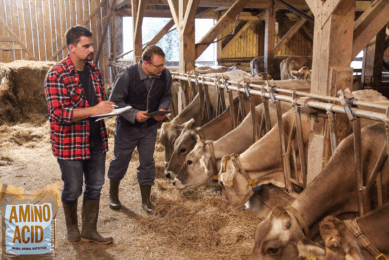Main breakthroughs in pig nutrition

The most significant breakthroughs in pig nutrition have become common practice for most nutritionists today.But it is also important to consider potential fields of research that could result in breakthroughs in the future says Anthony Edwards.
By: Anthony Edwards
Pig production has advanced remarkably over the past 30 years. Although much of this progress has been mediated by small but incremental improvements in production, sporadic but significant breakthroughs have accelerated this progress. Some of the significant breakthroughs are discussed below.
Ideal protein
The concept of formulating pig diets containing an ideal balance of essential amino acids to maximise the efficiency of protein utilisation was first reported in detail by the Agricultural Research Council (1981). This concept was refined by Fuller and Wang (1990), who showed that the amino acid requirement for maintenance differs from that for protein deposition and that the actual requirement is a combination of these components. Chung and Baker (1992) subsequently demonstrated that the level of cystine and threonine required for an ideal amino acid balance increases with body weight because the maintenance requirement increases with increasing body weight and these amino acids are predominant components of the maintenance amino acid profile. This research established that the optimal balance of essential amino acids is not fixed but varies according to body weight. This approach replaced previous methods of protein quality assessment such as the protein efficiency ratio, net protein utilisation, nitrogen retention and biological value as a more meaningful way of ascribing a relative value to a protein source based on its ability to complement other protein sources in a diet formulated using least-cost linear programming. This concept also superseded the limiting amino acid approach to protein assessment, which had little practical application. The ideal protein concept advanced feed formulation efficiency by enabling rapid identification of the optimum nutritional density of the diet (or least cost per balanced energy unit) using parametric analysis in which energy density is varied but the balance of the 114 total diet is maintained by linking lysine to energy and secondary essential amino acids to lysine in the ideal protein ratio and by ensuring that there is an adequate pool of non-essential amino acids.
Amino acid availability
Description of nutrients in feedstuffs on an available basis evolved over a long period involving much debate and many progressive refinements and, to some extent, still remains a little ambiguous. However, it was a major step forward from the simplistic digestible protein concept that preceded it. Key developments included:
• The development of ileal digestibility values to replace faecal digestibility values to avoid the confounding effects of hind gut fermentation.
• The progression from apparent to true digestibility values to correct for the confounding effects of endogenous secretions.
• In vitro assays (predominantly for lysine) for estimating available amino acid content using chemically reactive components such as flurodintrobenzine, dye binding, guanidination and homoarginine. Of these assays, the “reactive lysine” assay involving the homoarginine technique has emerged as the most reliable (Rutherfurd et al., 1997).
• Recognition that digestibility does not necessarily equate to utilisation and the development of techniques to assess true biological availability, e.g., the slope ratio and indirect oxidation techniques.
• Because of the expense and laborious nature of in vivo tests, the general consensus at present is to consider “standardised ileal digestibility” synonymous with “availability”.
• Expression of the amino acid content of feedstuffs on an “available” basis facilitates meaningful economic comparison and formulation of diets that result in consistent performance.
Protein and energy interactions
Quantification of the relationship between protein and energy in pig metabolism and growth by the Werribee Group (e.g., Campbell, 1987) and others resulted in a significant change in diet formulation procedures because of the development of protein to energy ratios for various stages of development, sexes and genotypes. The quantification of protein deposition rates and the metabolic cost of protein and fat deposition formed the basis for the quantitative algorithms that underpinned modelling approaches describing pig growth, including the Edinburgh model (Whittemore, 1986), the AUSPIG model (Black et al., 1986) and the Massey model (Moughan, 1981). These models established a scientific basis for nutrient requirements and replaced the more arbitrary values used previously. A degree of judgement was still required to translate these indicative requirements into commercial diet specifications but they helped to eliminate many of the erroneous anomalies that existed between various estimates of nutrient requirements and helped the industry to develop situation-specific solutions rather than use tabulated text book values for all situations.
Supplementary enzymes
The association between variation in pig performance and variation in grain composition was not identified as clearly as it was in poultry (e.g., the low metabolisable energy wheat syndrome) but there is now no doubt that it exists. However, it was quickly recognised that the beneficial effects of supplementary enzymes developed for poultry diets were relevant to pig diets.
Although the elucidation of complex grain matrix effects and the resolution of these effects using supplementary enzyme hydrolysis took many years to accomplish and involved inputs from many researchers, enzyme supplementation is now almost universally applied in the intensive livestock industry. Enzyme additives have improved the digestion of nutrients by abrogating the inhibitory effects of compounds such as arabinoxylans, ß-glucans, pectins, oligosaccharides, phytate, cellulose and protein-encapsulated starch and by supporting limited endogenous secretion of enzymes such as such as amylase, sucrase and proteases. Furthermore, they have enabled the problem of feed intake depression associated with certain feedstuffs to be resolved because they change the rate and site of digestion (Choct and Cadogan, 2001). The use of enzymes to improve phosphorus utilisation from phytate-bound sources has had profound environmental benefits as well as nutritional benefits. The additional benefits of phytases (improved amino acid and energy utilisation) have consolidated its economic merit (Ketaren et al., 1991).
Mycotoxin binders
The detrimental effects of mycotoxins have been recognised for many years, but until relatively recently, the only avenues of defence were avoidance, dilution or the use of clays such as bentonite. After reviewing opportunities for rapid and objective mycotoxin analysis of feed ingredients, the BECAN Consulting Group (1999) concluded that rather than pursue rapid analysis, livestock industries should develop more effective means of mycotoxin binding. Since then, breakthroughs have been achieved using various technologies that have resulted in effective, if not complete, detoxification. These include yeast-derived glucomannans, enhanced alumina silicates and bacterial/enzymic hydrolysis of active toxic components. Some of these products also have the capacity to effectively bind toxic alkaloids in ergot- and heliotrope-contaminated grain, which reduces the risk of toxicity when such grains are fed to livestock. Because of the broad array of potentially harmful mycotoxins and the difficulty of detecting them, it is often not practical or cost effective to test all materials for the full spectrum of toxins. On-farm storage of effective binders and detoxifiers facilitates immediate protection in the event of known mycotoxin contamination or prophylaxis in proportion to a perceived risk.
The emergence of effective binders has facilitated flexibility in raw material usage and has substantially reduced the risk of compromised production as a result of inadvertent mycotoxin contamination.
Metabolic modifiers
Exogenous porcine somatotrophin (pST) is possibly the most performance-enhancing technology that has emerged during the past 30 years. Initial research in the USA stimulated interest in pST and subsequent evaluation by the Werribee Group (Campbell et al., 1990a, b) resulted in commercial exploitation of the technology in the form of Reporcin. The magnitude of responses to this treatment (30% increase in protein deposition rate, 30% increase in feed conversion efficiency and 45% reduction in fat deposition; Campbell et al., 1991) is far greater than that of any other technology developed previously or since. The level of performance achieved with pST gives an indication of what pigs might be capable of 50 generations in the future. pST has extended the biological boundaries of growth well beyond any previous projections. Despite a number of shortcomings, such as the need for daily or regular injections, the not insignificant cost of the product, the labour required to administer it and the public perception of hormone use in meat production, pST remains a viable and registered product that is available to the pig industry in Australia and elsewhere in the world.
NIR to measure energy
The nutrient content of feedstuffs varies, which results in variation in livestock performance and production efficiency. The pursuit of a rapid, reliable, accurate and cost-effective means of feedstuff evaluation involved research on numerous methods, none of which were as successful as near-infrared reflectance (NIR). The application of NIR technology to stockfeed analysis evolved over many years and is now used in most quality assurance protocols to monitor a wide range of nutrients within feed ingredients and feeds. However, until recently energy content could only be monitored using time-consuming and expensive in vivo digestibility studies or was estimated from regression equations. The development of robust NIR calibrations for the digestible energy content of cereals for pigs was a major breakthrough (van Barneveld et al., 1999). These calibrations were subsequently expanded to include a range of feedstuffs under the auspices of the Premium Grains for Livestock Program (Pork CRC Ltd, Australian Pork Limited, Grains Research and Development Corporation). The recently launched AusSCAN service affords the commercial livestock and feed milling industries access to NIR analysis, which will improve the consistency of livestock performance and facilitate more informed feedstuff purchasing decisions.
Future developments and challenges
Numerous aspects of pig nutrition are currently the subjects of research, and progress will no doubt be achieved. Whether or not the progress will be significant enough to be classified as a “breakthrough” is hard to predict. Research fields that show promise include nutrient asynchrony for example. Another area where future breakthroughs can be expected is the science of the interactions between the immune system and nutrients.
Also the role of amino acids is better understood nowadays and will receive more attention in the future as well. The classic perception of amino acids is that they are only precursors for protein synthesis. However, other functions of amino acids such the role of glutamic acid in mucosal metabolism and regulation of enteric microflora, the role of arginine in nitric oxide generation and the sedative effects of tryptophan have been identified. Although the traditional approach to the inclusion of non-essential amino acids in diets is to ensure that the level of non-essential amino acids is adequate relative to that of essential amino acids, specific combinations of amino acids may result in more efficient protein accretion. There is increasing evidence that the provision of specific nutrients at key points in the reproductive and growth cycles has positive effects. The likelihood of a breakthrough in this area is significant. Although liquid feeding is not a new concept, its potential has not been realised. Future changes in raw material access could result in extensive application of liquid feeding to increase feed efficiency, address environmental concerns and improve profitability. The use of NIR will be increased in the future, where this technique will be used for many more applications. <-
References are available on request
Source: Feed Mix Volume 17. No.6











